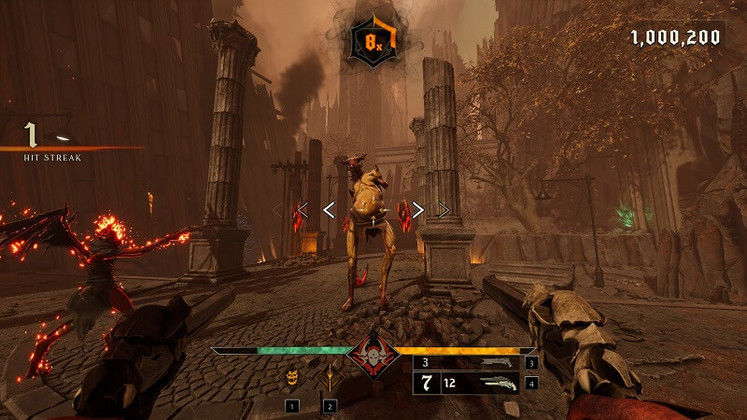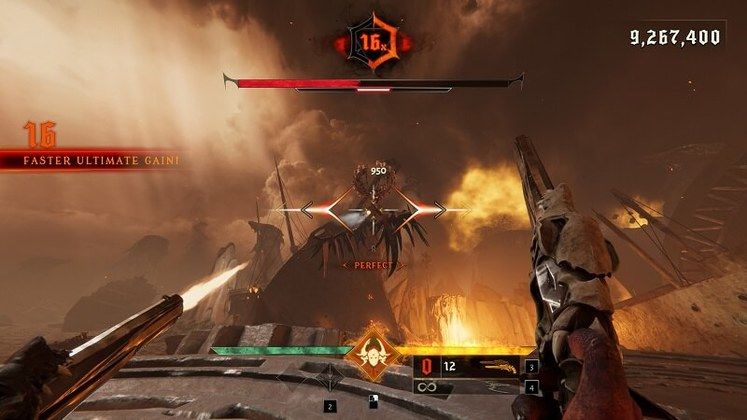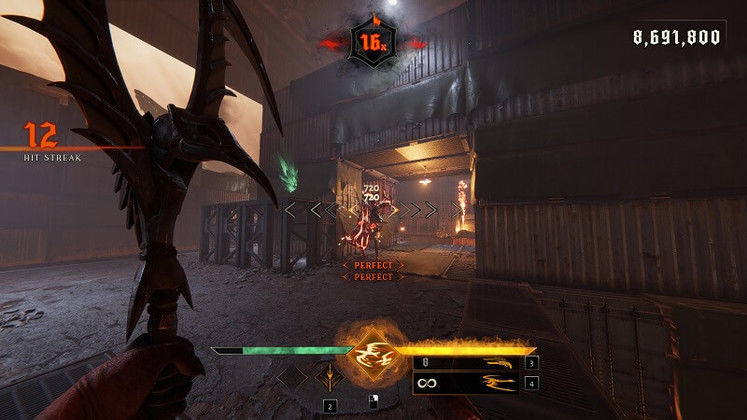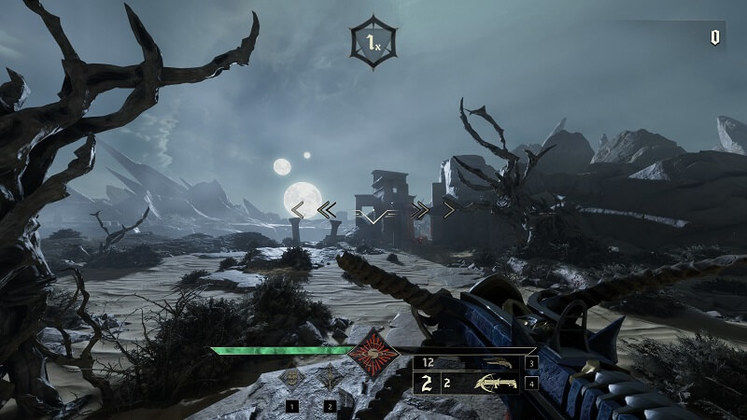Metal: Hellsinger Review
Shotgun Symphony
In Doom Eternal, tracks like BFG Division or Meathook often triggered one reflex that had me trying to line up my shots with their rhythm. Adding my shotgun blasts to the crushing sound of downtuned guitars gave the loose, chaotic pacing of those encounters a temporary sense of harmony and structure while making me feel like I was wrecking demons a smidge harder than usual.
Metal: Hellsinger puts this concept at its center. Matching your actions to the beat of the songs accompanying you on your journey is a key part of gameplay; and the way developer The Outsiders blends it and more traditional first-person shooter elements makes for one of the most intense games of the year.
In Metal: Hellsinger, you step into the role of the Unknown, a demon with vengeance on her mind and no shortage of bullets or death-dealing implements.
The story is mostly told through pre-level cutscenes narrated by Paz, your newfound skull companion, who does a good enough job at explaining why you’re a little extra pissed and mowing down every demon that dares step in your way.
It’s not really intertwined with the levels and won’t blow anyone’s mind with its narrative prowess, but it does paint a broader picture of the world you’re ravaging.
Metal: Hellsinger’s trump card is, without a doubt, the aforementioned blend of fairly standard but well-executed first-person shooter mechanics and rhythm game elements. A nimble fighter capable of quickly dashing out of harm’s way and double jumping to elevated positions, the Unknown also has an arsenal of six different weapons at her disposal.
Two are available from the start and always present in your loadout. Paz acts as a weaker ranged weapon that you can use to more reliably set up Slaughter kills – bloody melee executions which replenish health. Terminus, your sword, is perfect when you need to eliminate enemies up close.
You unlock the remaining four by playing through the story, after which you can add any two of them to your loadout before each new run. You can mix and match precise dual pistols, a devastating shotgun, a rather explosive crossbow, and sharp, crow-shaped boomerangs.
Needless to say, each weapon has its own fire rate and reload speeds, which you’ll need to get used to. But only shooting won’t get you too far in Metal: Hellsinger. From the very first moments of each level, a dedicated song plays while the arrows of the rhythm indicator perpetually move towards the center of the screen.
Timing your actions – whether shots, reloads, dodges, or executions – to the beat not only feels incredibly satisfying to pull off but also makes you deal more damage and earn higher scores. Keeping hit streaks up grants further boons that turn you into an even more potent killing machine.
Landing shots also charge up ultimate attacks that usually have devastating consequences for any foe caught in their wake. Should you ever fall in battle, you can sacrifice some of your earned score for another chance to fight.
As you kill enemies while staying on beat, you bump up the Fury multiplier shown at the top of the screen. Old school-style Fury
Boost pickups spread across the game’s combat arenas also help out, offering a pick-me-up when things become a bit overwhelming or you fall off the beat.
In addition, while most weapons only increase Fury upon landing hits, Paz helps you maintain your current multiplier level by simply firing to the rhythm, regardless of whether or not you hit anything.
At first, switching to the skull and constantly shooting feels a bit odd, but once you get used to it, it lets you maintain momentum when moving between combat arenas and also helps you keep track of the music’s pulse.
While level-specific leaderboards act as an incentive to aim for the maximum multiplier, the tune’s intensity also increases the better you do, progressively adding more layers. At the highest level (x16), the vocals join in alongside all the other instruments, completing the puzzle.
These seamless transitions act as a natural reminder that you need to hone in on that rhythm and add your shots to the brutal symphony cooked up by composer duo Two Feathers.
As cliché as it sounds, at its peak, it felt like I became one with the songs, each killing blow directed by the crash of drums, distorted electric guitars, and death growls; and there were many such peaks during the 6 hours it took me to beat the story mode and beyond.
I was so absorbed by the intensity of the music and blasting foes apart that, at times, I literally forgot to dodge out of harm’s way, almost ending up dead. Metal: Hellsinger’s soundtrack is an absolute treat if you’re into heavy music.
The instrumentals themselves are great on their own – exploring more territories than just syncopated downtuned guitar riffs – but names such as Arch Enemy’s Alissa White-Gluz, Trivium’s Matt Heafy, and System of a Down’s Serj Tankian greatly help elevate the songs.
Conversely, if you’re not a fan of metal music, you may have a more difficult time getting into the game. Even if its lowest difficulty is more forgiving, the songs that play as you shoot your way through Hell remain the same.
Visually, the eight levels – nine if you count the short tutorial – share a common theme of desolation. There are few massive structures or sights that burn into your mind; if you’re expecting Doom Eternal levels of grandeur or devastation you won’t find them here.
But the caves lit by pools of lava and rocky or icy stretches you traverse are permeated by a sense that spending time there for reasons other than shooting demons probably isn’t all that enjoyable.
It’s a subtler way of painting a picture of Hell that, to me, felt partially intended and partially resulting from a smaller budget.
Each level concludes with a fight against an Aspect – a boss with its own dedicated arena. Although mechanically different to some extent – incorporating elements reminiscent of bullet hell games at times - these encounters aren’t all that visually stimulating.
The bosses themselves look particularly fearsome at first, but fail to create a lasting impression due to how subsequent fights pit you against variations on the same base model.
This takes away from what should be the climax of a series of hard-fought battles. In addition, these encounters also rely a little too much on summoning regular demons when the bosses reach certain health thresholds.
It’s partially done to give you a means to heal – through Slaughter executions – in case you’ve used up all the replenishing green crystals spread around the arena; it also makes these fights rather predictable and, towards the end, tiring.
There’s a certain lack of variety to them that’s not present elsewhere – even with the game’s fairly small roster of enemies – leaving me with an impression of unfulfilled potential just as I was heading for the score screen to see how well I did.
Make no mistake, they did keep me on my toes, even getting the best of me on a few occasions; but they also left me wondering how cool it would have been if I wasn’t just fighting the same strange flying heads.
Finishing most levels also allows you to take on additional challenges in the shape of Torments. These are smaller, more focused battles that task you with killing a set number of enemies in a limited amount of time while applying a special rule.
You could end up forced to switch weapons after each kill or be unable to heal but deal increasingly more damage the closer you are to death.
Completing them rewards and lets you upgrade Sigils; passive boons which empower the main character during story levels. You can equip up to two, offering passive effects such as protecting your hit streak or making the first couple of shots after switching weapons and not consuming ammo.
They’re a very welcome addition, meant to make you more efficient as you chase those higher scores, albeit not one that transforms subsequent runs into wholly new experiences.
The story mode itself is well worth playing through just for its distinct flavor of first-person shooter action, but competing for the top spot on the leaderboards and perfecting your runs makes up the bulk of Metal: Hellsinger’s post-story aspirations.
Performance
On an i7-8700K, 16 GB RAM, Nvidia RTX 3080@1440p, the game ran without a single hiccup.
Acessibility
Rather a lean offering at launch, limited to rebindable keys alongside a couple of options that allow you to customize the HUD and subtitles.
METAL: HELLSINGER VERDICT
Metal: Hellsinger’s infectious blend of rhythm game and first-person shooter elements gripped me all the way through its story mode and beyond, despite its mostly disappointing boss battles. Its roaring metal soundtrack ebbs and flows around how well you deal death to Hell’s denizens, constantly pushing you to do better.
It’s some of the most intense action that I’ve experienced this year and a game you should definitely put on your radar, especially if you love both first-person shooters and metal music.
TOP GAME MOMENT
Reaching maximum Fury on each level and hearing the full might of the game’s soundtrack as I synchronized my shots to its rhythm.
Good vs Bad
- Excellently blends rhythm game and first-person shooter elements
- Intense action doubled by an awesome metal soundtrack
- Known vocalists elevate the songs they're featured on
- Cool guns, each one behaving differently
- (Mostly) disappointing bosses
- (Too) barren rendition of hell might not suit everyone’s taste














